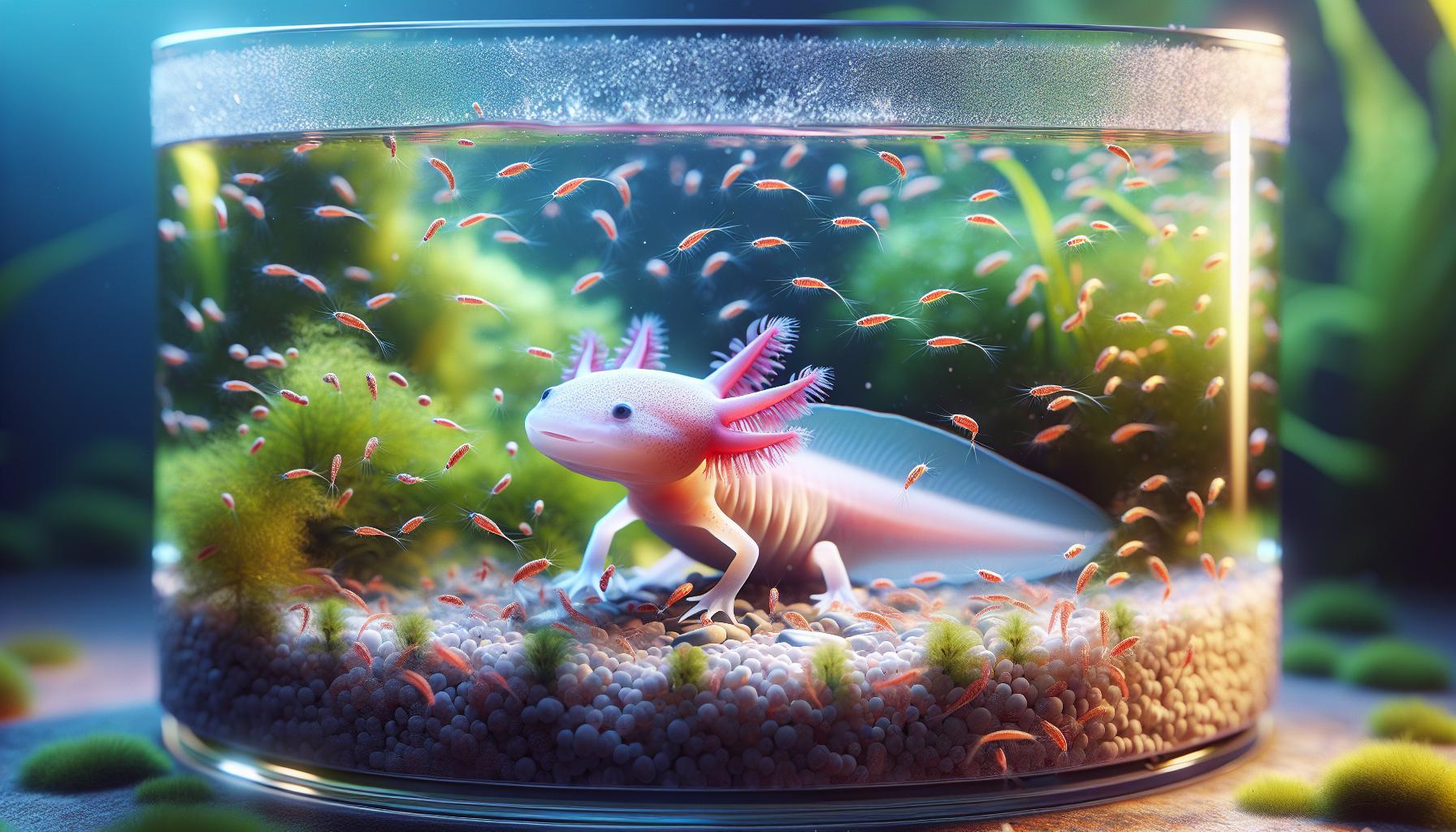Have you ever seen a creature that looks like it jumped straight out of a fantasy world? Meet the baby:sa1bxvskd0u= axolotl, a captivating amphibian that’s captured the hearts of many. With its feathery gills and playful demeanor, this unique little critter has become a popular pet and a symbol of conservation efforts.
I find it fascinating how the axolotl’s enchanting appearance belies its remarkable biological traits. These creatures are not just cute; they possess incredible regenerative abilities that set them apart in the animal kingdom. In this article, I’ll dive into the world of baby axolotls, exploring their care, habitat, and the joy they bring to our lives. Whether you’re a seasoned pet owner or simply curious, you’ll discover why axolotls are truly special.
- Unique Characteristics: Baby:Sa1bxvskd0u= Axolotl, or larvae, are distinct with their vibrant colors and range in size from 1 to 2 inches, showcasing shades like golden, albino, and wild-type patterns.
- Optimal Care Requirements: They thrive in a tank of at least 10 gallons, with water temperatures maintained between 60°F and 70°F, focusing on high water quality to support their health.
- Diet and Feeding Schedule: A balanced diet of small live foods, like brine shrimp and daphnia, along with several feeding sessions a day, is essential for their rapid growth and well-being.
- Behavioral Traits: Observing their playful and curious nature is key; although solitary, they can coexist peacefully with appropriate tank mates, and their activity levels can indicate overall health.
- Conservation Symbol: Axolotls are not only beloved pets for their charming appearance but also play a significant role in conservation efforts, highlighting the need to protect their natural habitat.
Baby:sa1bxvskd0u= Axolotl
Baby:Sa1bxvskd0u= Axolotl, often called larvae, exhibit unique characteristics that distinguish them from adult axolotls. These juvenile axolotls typically measure between 1 to 2 inches long. Their vibrant colors include shades of golden, albino, and wild-type patterns.
Caring for baby axolotls requires attention to their aquatic environment. They thrive in water temperatures of 60 to 70°F. A suitable tank size starts at 10 gallons, with a secure lid to prevent escapes.
Feeding baby axolotls involves providing small live foods like brine shrimp, daphnia, or specially formulated axolotl pellets. It’s essential to feed them several times a day, as their growth rate accelerates with proper nutrition.
Monitoring water quality is critical for their health. Regular testing for ammonia, nitrite, and nitrate levels ensures a safe environment. A filtration system can help maintain water quality, while partial water changes should occur weekly.
Understanding the unique attributes of baby axolotls enhances the experience of keeping them as pets. Their playful behavior and engaging personalities contribute to their appeal, making them delightful companions for aquarists.
Physical Characteristics

Baby axolotls display unique physical attributes that contribute to their charm and appeal. Understanding these characteristics helps in caring for them and appreciating their distinctiveness.
Size and Color Variations
Baby:Sa1bxvskd0u= Axolotl, or larvae, typically range from 1 to 2 inches in length. As they mature, they can grow up to 12 inches. Color variations include:
- Golden: Bright yellow hues.
- Albino: White bodies with red or pink gills.
- Wild-Type: Dark pigmentation with mottled patterns.
- Leucistic: White or pale skin with dark eyes.
These colors can change slightly as they grow, showcasing their adaptability.
Distinct Features
Distinct features of baby axolotls enhance their overall appearance. Notable characteristics include:
- External Gills: Feather-like structures that extend from the sides of their heads, allowing for efficient underwater respiration.
- Wide Heads: Broad, flat heads that add to their endearing look.
- Fin Structure: A dorsal fin that runs along the length of their body, providing propulsion in water.
- Limb Development: Tiny limbs start to develop as they approach maturity, further enhancing their unique silhouette.
These features contribute to the axolotl’s reputation as a captivating and cherished pet in many aquarist households.
Habitat and Care Requirements

Creating the right habitat for baby axolotls is essential for their growth and health. Specific setups ensure their well-being in captivity.
Tank Setup
I recommend using a minimum tank size of 10 gallons for baby axolotls. A larger tank allows for stable water conditions and provides space for movement. Incorporate a substrate like sand or smooth gravel to prevent ingestion during feeding. Include hiding spots made of plants or decorations, offering security and reducing stress. It’s crucial to avoid sharp objects that could injure their tender skin or gills. Ensure a secure lid to prevent escapes, as these curious creatures may jump.
Water Quality and Temperature
Maintaining optimal water quality is vital for baby axolotls. I test the water regularly for ammonia, nitrite, and nitrate levels, keeping them at 0 ppm for ammonia, 0 ppm for nitrites, and less than 20 ppm for nitrates. Performing weekly partial water changes of 20-30% helps maintain a clean environment. The water temperature should stay between 60°F and 70°F, as temperatures outside this range can stress them or lead to health issues. Implement a reliable filtration system to promote water circulation and cleanliness while ensuring it operates quietly, as axolotls are sensitive to strong currents.
Feeding and Diet

Feeding baby axolotls demands attention to their specific dietary needs. A balanced diet is crucial for their health and growth, so choosing the right foods and maintaining a consistent feeding schedule ensures optimal development.
Recommended Foods
I recommend feeding Baby:Sa1bxvskd0u= Axolotls a variety of small, nutritious foods to support their rapid growth. Live foods like brine shrimp and daphnia work well due to their high protein content and small size. Additionally, finely chopped earthworms or specially formulated sinking pellets are excellent options. Commercial axolotl or aquatic amphibian food can also provide essential nutrients. Always ensure that food sizes are appropriate for the small mouths of these larvae to prevent choking.
Feeding Schedule
To promote healthy growth, I advise feeding baby axolotls several times a day. Aim for 2 to 3 feeding sessions, offering only what they can consume within 10 minutes. This approach minimizes waste and keeps water quality high. Adjust feeding amounts based on growth progress and ensure that leftover food is removed promptly to maintain a clean habitat. Keeping a consistent schedule helps establish a routine, enhancing overall health and wellbeing.
Behavior and Temperament
Axolotls exhibit unique behaviors that reflect their playful and curious nature. Understanding these traits is essential for their optimal care and enrichment.
Social Interactions
Baby:Sa1bxvskd0u= Axolotl are generally solitary creatures. They do not require company from other axolotls but can coexist peacefully with tank mates if carefully selected. Maintaining a suitable environment prevents stress and territorial disputes. When interacting with others, axolotls may display curiosity, swimming close to investigate. It’s important to monitor interactions, as other species might trigger stress or aggression.
Activity Levels
Baby axolotls are moderately active, spending a significant amount of time exploring their aquatic environment. They swim around during feeding times and exhibit playfulness by hiding and darting through tank decorations. Providing enriching elements like plants and caves enhances their activity, promoting natural behaviors. Monitoring their activity levels can also help detect health issues. Regular movement signifies a healthy, engaged axolotl, while lethargy might indicate stress or illness.
Caring for Baby:Sa1bxvskd0u= Axolotl can be a rewarding experience. Their unique characteristics and playful nature make them captivating companions. By providing the right environment and proper nutrition, I’ve found that these little creatures thrive and bring joy to my life.
Watching them grow and develop is truly fascinating. Their vibrant colors and curious behaviors never fail to brighten my day. With the right knowledge and commitment, anyone can enjoy the delightful journey of raising baby axolotls, making them a wonderful addition to any aquatic setup.

